When Is It Appropriate To Add Pronoun Guide To Your Signature
[Update]: This commodity was first published on January 26, 2021. It's been updated to present the new way for setting upwards gender pronouns with our User attributes managing director.
Gender pronouns are becoming an essential part of every professional email communication and companies now tend to include gender data in their electronic mail signature policy. In this article nosotros'll highlight the importance of gender pronouns and show you how to apply them in email signatures in your arrangement.
The importance of gender pronouns
Pronouns in email signatures show how the email senders identify themselves and how they would similar to be referred to in the third person. Using them in email signatures can send a message that the company is inclusive of anybody and acknowledges gender diversity. Moreover, gender pronouns are not only a nod to the LGBTQ+ customs, just as well an important matter for people with a gender-neutral name who practise non have thoughts on their innate gender identity. On the other hand, some people might not exist comfortable adding those pronouns to their signature. Numerous representatives of both mindsets can be found on net forums, confirming that this topic remains controversial. Take this into account and be sensitive when making the decision to include gender pronouns in e-mail communication. Giving the employees a choice whether or not they desire to include pronouns in their email signatures can assistance companies avoid friction among their staff. And remember, pronouns lone shouldn't be treated as the visitor'south but try to be more inclusive of gender identity.
Adding gender pronouns to electronic mail signatures can make things easier and relieve time. Some people spend a lot of fourth dimension wondering how to address the person they are writing to. Wrongly assuming someone's gender tin can have a horrible impact on the offset impression and might fifty-fifty hurt someone's feelings. To remedy this problem, some people try to avoid using pronouns at all costs. The result – rephrasing an e-mail – might take even more time and, in some cases, tin can end with the message sounding only bad-mannered.
Examples of gender pronouns in signatures
How y'all add pronouns to your email signature template depends highly on your signature design. Pronouns should grade an integral function of the signature. If you decide to include gender pronouns in your email signature, information technology's best to add them next to your name. That's where most people wait to see this data.
See the examples beneath to learn how to best include gender pronouns in email signatures:
Sample signature ane
Sample signature two
Sample signature 3
How to set up
Now that I've explained the basic concept, I'll show you how to fix up signatures with gender pronouns for the whole company. Since setting information technology up is different for Microsoft 365 and Exchange Server, I'll present a separate guide for both platforms to yous:
- How to add gender pronouns to email signatures in Microsoft 365
- How to add together gender pronouns to email signatures in Commutation Server
How to gear up gender pronouns in Microsoft 365
Using CodeTwo User attributes manager
In this example, a company called Company is using Microsoft 365 for their email needs and manages e-mail signatures using CodeTwo Email Signatures for Office 365. This service lets admins update email signatures for the entire visitor in a matter of seconds, regardless of email clients and devices used to communicate.
In order to add together pronouns to email signatures, I volition employ User attributes manager which is a complimentary characteristic for all licensed users of CodeTwo Email Signatures for Office 365. This style, the entire setup and control over gender pronouns can be handled conveniently within the deject-based email signature management service.
Usually, all personal information constitute in signatures is taken directly from Azure Active Directory. Notwithstanding, User aspect manager lets y'all manage personal information without making any changes to Active Directory itself. Larn more well-nigh User attribute manager in this short video
Beginning, I need to sign in with my Microsoft 365 global admin credentials at attributes.codetwo.com. The Aspect visibility page lists all users' attributes stored in CodeTwo Azure Advertizing enshroud and added to email signatures. Here, I can cull which of the listed attributes I want to make visible and editable for end users.
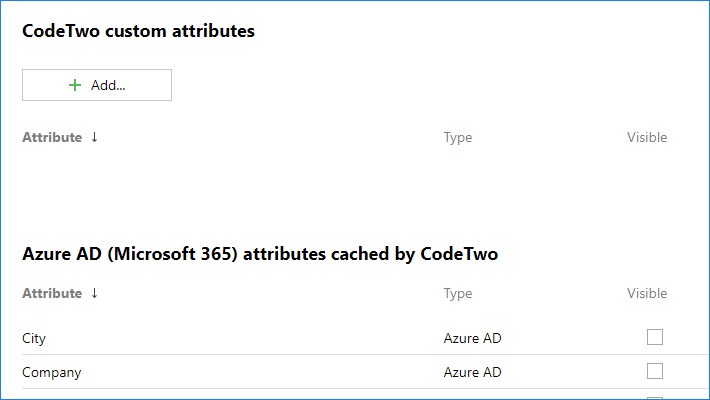
The page also lets me create custom attributes – all I need to do is select Add, create the new Pronouns aspect, click ADD and Relieve.
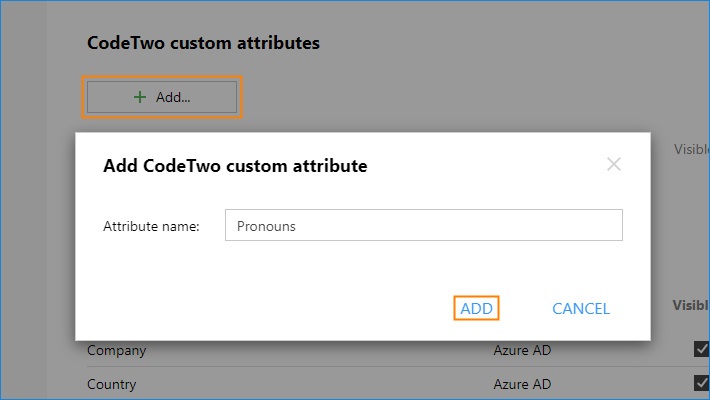
The adjacent step is to ask all employees to fill out the requested details (within a specified time frame) at user.codetwo.com (this is possible only later the setup at attributes.codetwo.com is complete). To ensure structured feedback, I ask everyone to provide 1 of the following options:
- (he/him/his)
- (she/her/hers)
- (they/them/their)
Also, I point out in my communication that users who would rather non have any pronouns included in their signatures should leave the field blank.
Within the User info editor, the users can meet a listing of attributes I made available to them previously in the User attributes managing director. Items set up by me as read-only are grayed out.
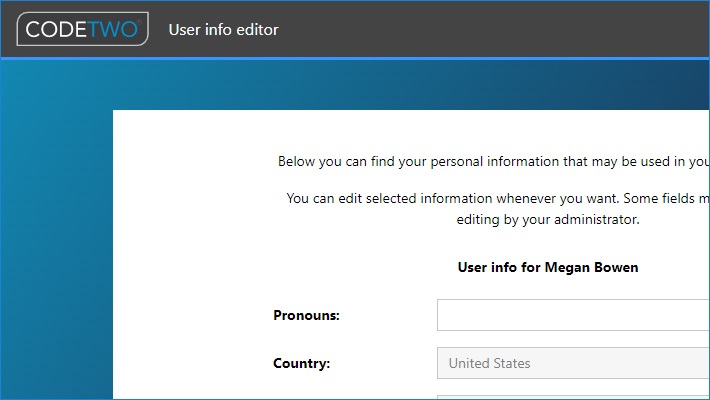
Note: nothing stands in the mode to make only ane specific aspect visible and bachelor for editing. Although, depending on the scenario, information technology might be required to brandish boosted attributes to provide end users with more than context.
One time the feedback has been provided, I want to make sure that the data is correct and complimentary of typos – another task made easy thank you to the User attributes manager. The Import/Export page at attributes.codetwo.com allows for bulk management and editing of attribute values for multiple users.
To bulk edit Azure AD attributes stored in CodeTwo Azure AD cache, first I click the Export to CSV button, download the CSV file and open information technology with Microsoft Excel (text editors such as Notepad or Notepad++ volition too work). The file contains a list of end users and attribute values they have provided. Empty cells stand for attributes which values have not been modified and remain the aforementioned equally in the arrangement's Azure Active Directory.
Now, I tin can do a quick review of the values listed in the Pronouns column. That'southward when I set up the typos and clear more creative entries like "I'd rather not have this data in my signature". Once I'thou washed, all I need to do is relieve the file, click the Import from CSV button and choose Selective import. I click IMPORT afterwards to finish.
Annotation: After the initial setup, I change the gender aspect to uneditable. This fashion, there shouldn't be whatsoever surprises in the company'due south email signatures and if anyone wants to modify their details afterwards, they can achieve out to the admin.
Once the update of user's details is complete (this usually takes a few minutes just in very rare cases may accept upwardly to several hours) I can head to app.codetwo.com (or click the Signatures tab in CodeTwo Admin Panel) and select a signature rule I want to use. Then, I go to the Blueprint tab and click Edit signature to open the Signature template editor.
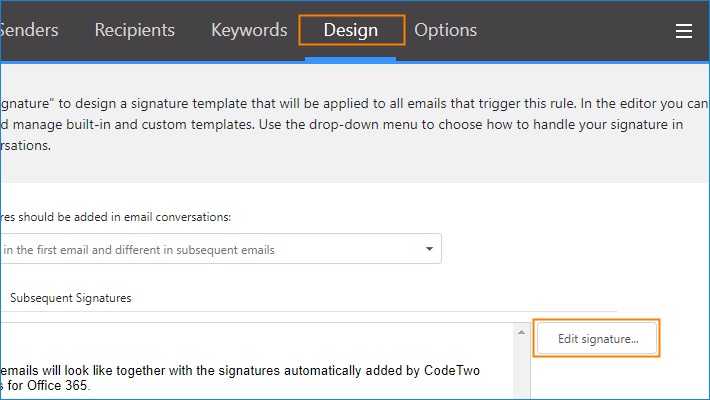
In the signature template editor, I place the cursor where I desire the new placeholder to be located in my signature. And then, I go to Placeholder > Message Sender > Additional attributes and select the desired attribute, as shown in the image beneath.
Notation: if pronouns are added in a split line or have a signaling phrase before them (like Pronouns:), I can add a Remove Text tag. This manner, if the attribute value is empty, the additional line and the signaling phrase volition non be added. Learn more most using Remove Text tags
In one case I'm washed, I need to salve my changes and close the Signature template editor past using the Apply & Close button and submit them to CodeTwo Azure servers past clicking the Save button.
Learn more about the User attributes director
Click to expand/hide alternative approaches
Culling approaches
The post-obit function of the article covers two culling, more fourth dimension- and endeavour-consuming methods for setting up gender pronouns in Microsoft 365 – without the utilise of the User attributes manager. In both of them, a company called Company is using CodeTwo E-mail Signatures for Office 365 for e-mail signature management in Microsoft 365. Admin admission to the Microsoft 365 tenant is required in both cases to continue.
Grooming
To be able to outset, I need to gather information from employees on which pronouns to include in their signatures. To achieve this, I've sent a survey to all employees with the following options to choose from:
- (he/him/his)
- (she/her/hers)
- (they/them/theirs)
- I'd rather non have any pronouns included
I've collated the feedback in a CSV file with two columns: User (represented past the user'due south UPN) and Pronouns with possible values: (he/him/his), (she/her/hers), (they/them/their), blank. Here's how a sample CSV file looks similar, viewed in Microsoft Excel:
The sample CSV file tin can be downloaded here. Just instead of relying on the sample file, yous can speed things up by using PowerShell to create a pre-filled CSV file.
As the first step, I demand to connect to Exchange (Online) or run Exchange Direction Trounce. When I have my panel running and connected, I can utilise the following script:
go-mailbox | select @{northward="User";e={$_.UserPrincipalName}},@{north="Pronouns";due east={""}} | export-csv c:\pronouns.csv -NoTypeInformation This script creates a CSV file with two columns:
- The User column prefilled with UserPrincipalName of all mailboxes in your organization.
- The Pronouns column without whatsoever values.
I can ready a different location for the output file (c:\pronouns.csv in this example), filter mailboxes to include only user mailboxes (add the "-RecipientTypeDetails UserMailbox" attribute to the Get-Mailbox cmdlet) etc.
After the file is created, I just need to open it, specify values in the Pronoun column for each user and save my changes. In one case done, I'm ready for the side by side steps.
Using Groups and Provisional Placeholders
In this method, I will create 3 distribution groups in Microsoft 365, add together members based on the CSV file and configure an email signature rule to add together pronouns to user's electronic mail signatures.
First, I connect to my Microsoft 365 tenant using the Exchange Online PowerShell module (see instructions on how to do this). So, I import the survey's results from the CSV file (see how to create a CSV file):
$pronouns = (import-csv C:\pronouns.csv) After the results have been imported, I create 3 distribution groups:
New-DistributionGroup -Name "Pronoun-He" -Members ($pronouns | where -property pronouns -like "*him*").user; New-DistributionGroup -Proper name "Pronoun-She" -Members ($pronouns | where -property pronouns -similar "*her*").user; New-DistributionGroup -Name "Pronoun-They" -Members ($pronouns | where -property pronouns -like "*they*").user; Now, I get to app.codetwo.com (or click the Signatures tab in CodeTwo Admin Console) and select a signature rule I want to utilize. Then, I go to the Design tab and click Edit signature to open the Signature template editor.

When the editor opens, I demand to add together a new conditional placeholder. To do so, I go to Placeholder > Conditional Placeholders > Manage.
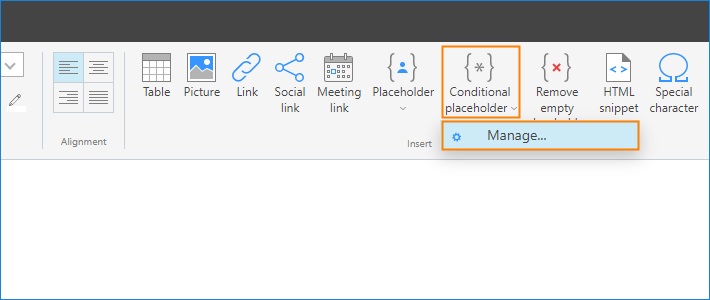
In the Conditional placeholders manager, I add a new conditional placeholder, name it Pronouns and add together placeholder rules, as shown beneath. I leave the default placeholder value empty. With the current setup, if a user is a fellow member of one of the groups – they will have their gender pronouns added to their signature. If someone is not a member of any of those groups, they volition receive a default (bare) placeholder. After I finish setting up placeholders, I click Salve to close the manager.
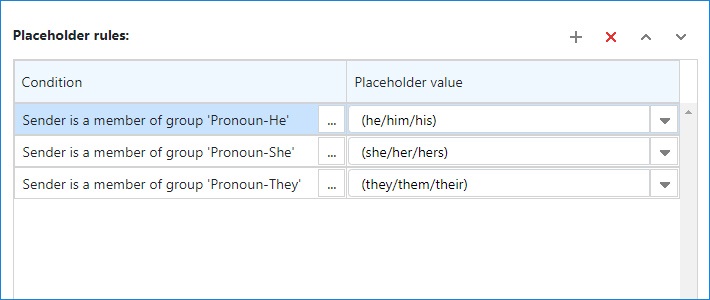
Finally, in the editor's main window I put the cursor where I want the new placeholder to be and add information technology past clicking Conditional placeholder > Pronouns.
Note: if pronouns are added in a split up line or take a signaling phrase before them (like Pronouns:), I can add a Remove Text tag. This manner, if the attribute value is empty, the boosted line and the signaling phrase volition not be added: Acquire more than about using Remove Text tags
At present I tin can save the template, shut the editor and employ changes to the signature-adding service.
Learn more about using Conditional placeholders
Using Custom Attributes
In this case, I will add custom attributes to user's mailboxes and use them in an e-mail signature rule afterwards.
Equally a reminder, I accept a CSV file with all my users and the pronouns they wish to have in their email signatures.
Like in the previous method, first I need to get-go a remote connection with Exchange Online (run across instructions on how to do this). Next, I'm importing values from my CSV file and upload them to my users' custom attributes. In the example, I have my CSV file in C:\pronouns.csv and I'm using CustomAttribute7:
$pronouns = (import-csv C:\pronouns.csv); foreach ($user in $pronouns) {Set up-Mailbox $user.user -CustomAttribute7 $user.pronouns} At present, I open up the Manage Signatures App and edit the email signature rule to which I desire to add together pronouns. To do so, I go to the Blueprint tab and click Edit signature.

In the signature template editor, I put the cursor where I want the new placeholder to be located in my signature. Then, I use the placeholder menu to add the custom attribute I've just modified in PowerShell (in this example information technology's CustomAttribute7) as shown in the image below.
Note: if pronouns are added in a carve up line or have a signaling phrase before them (like Pronouns:), I tin can add a Remove Text tag. This way, if the attribute value is empty, the additional line and the signaling phrase will not exist added: Learn more about using Remove Text tags
Afterward I'm done, I need to save changes, shut the Signature template editor and Apply the changes to CodeTwo Azure Service.
Learn more about using custom attributes
The outcome
Regardless of which method you choose, all of your users should have their pronouns automatically added to their email signatures. Similar this:
Thank you to CodeTwo Email Signatures for Part 365, every user in your system can have a personalized e-mail signature containing their preferred gender pronouns. The signatures are managed centrally without user interest, making sure that no employee is excluded and that the signatures will work on every device and in every email client.
How to prepare upwards gender pronouns in Commutation Server
If your visitor uses Exchange Server, there are ii easy ways to add together gender pronouns to each email signature. The simply requirement is to manage e-mail signatures centrally with CodeTwo Exchange Rules. Thanks to this plan, y'all can set up upward and update e-mail signatures for each and every user. These signatures are added on the server level, and then information technology doesn't matter what devices and email clients are used in the system – the right and upward to date signature will be at that place each time.
Grooming
Before I start, I demand to gather information from employees about which pronouns they want to accept included in their signatures. In this example, I've sent a survey to all employees with the post-obit options to choose from:
• (he/him/his)
• (she/her/hers)
• (they/them/their)
• I'd rather not have whatsoever pronouns included
I've gathered all the replies in a CSV file with two columns: User (represented by the user's UPN) and Pronouns with possible values: (he/him/his), (she/her/hers), (they/them/their), blank. Here's how a sample CSV file looks like, viewed in Microsoft Excel:

Y'all can download the sample CSV file here. Simply at that place is a much improve manner than relying on the sample file. I'll show you how to create a pre-filled CSV file using PowerShell.
Before I begin, I need to connect to Exchange (Online) or run Exchange Direction Crush. When I accept my console running and connected, I can use the post-obit script:
get-mailbox | select @{n="User";eastward={$_.UserPrincipalName}},@{n="Pronouns";east={""}} | export-csv c:\pronouns.csv -NoTypeInformation This script creates a CSV file with two columns:
- The User column prefilled with UserPrincipalName of all mailboxes in your organization.
- The Pronouns column without any values.
I can utilize a different location for the output file (c:\pronouns.csv in this example), filter mailboxes to include but user mailboxes (add the "-RecipientTypeDetails UserMailbox" attribute to the Get-Mailbox cmdlet) and so on.
Afterwards the file is created, all I need to do is open up the generated file, specify values in the Pronoun column for each user and relieve the file. Subsequently that, I'thou set for the next steps.
Creating dedicated distribution groups and provisional placeholders
In this method, I'll create 3 distribution groups, based on the CSV file I've created earlier. In my Exchange Management Shell, I run the following code:
$pronouns = (import-csv C:\pronouns.csv)
Afterwards the contents of the table have been imported, I create 3 distribution groups:
New-DistributionGroup -Proper name "Pronoun-He" -Members ($pronouns | where -property pronouns -similar "*him*").user; New-DistributionGroup -Name "Pronoun-She" -Members ($pronouns | where -property pronouns -like "*her*").user; New-DistributionGroup -Name "Pronoun-They" -Members ($pronouns | where -belongings pronouns -like "*they*").user;
At present I tin check if the DGs have been correctly populated using the Get-DistributionGroupMember cmdlet:
Get-DistributionGroupMember "Pronoun-He"
If everything seems fine, I tin can launch my CodeTwo Exchange Rules Administration Panel, choose the signature rule I want to modify and get to Actions > Insert signature > Edit:

In the signature template editor, I go to Placeholder > Conditional placeholder > Manage:
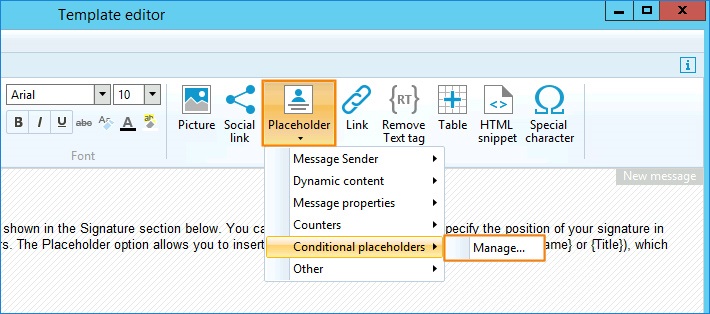
Now, I need to add a new placeholder using the plus button (i). Later on providing the proper name for the new placeholder, I click OK (2) and create a new placeholder rule using the plus button on the right (three):
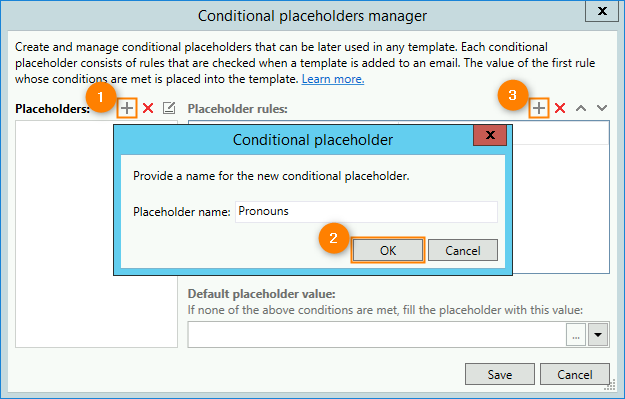
In the Placeholder rule conditions architect window, I choose the condition Sender is a fellow member of group and select ane of the distribution groups I've created earlier. Next, I click OK to select the group and OK once again to create the first placeholder dominion. I demand three separate rules, each with ane of the Pronouns groups.
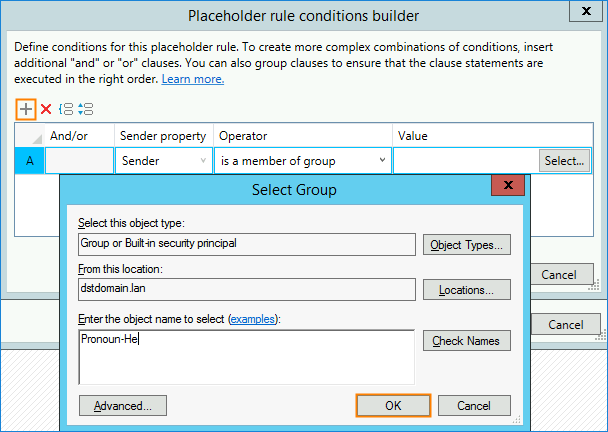
When three conditions are specified, I specify placeholder values for each group and leave default as blank (for those who accept chosen not to specify their pronouns preferences). I click Save to create the pronouns conditional placeholder:
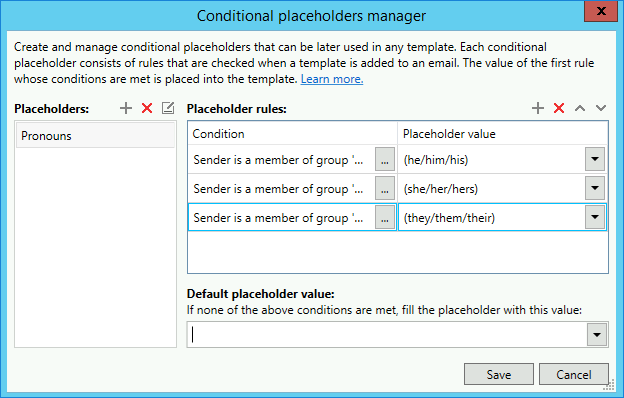
Now, I move the cursor to the location I want pronouns to announced in the signature and go to Placeholder > Conditional placeholders > Pronouns:
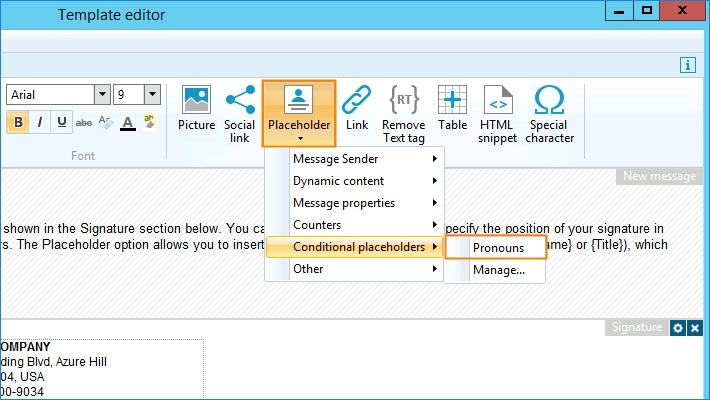
Notation: if pronouns are added in a divide line or take a signaling phrase earlier them (like Pronouns:), I tin can add together a Remove Text tag. This way, if the attribute value is empty, the boosted line and the signaling phrase will not be added: Learn more about using Remove Text tags
If I always demand to update the pronoun values for whatever user, I will remove them from one distribution group and add to another.
Using Extension Attributes
Another way to add pronouns to each electronic mail signature in the company is using Exchange Extension Attributes (or custom attributes). The easiest way to prepare them up is to use PowerShell via the Exchange Management Shell:
$pronouns = (import-csv C:\pronouns.csv); foreach ($user in $pronouns) {Set-Mailbox $user.user -ExtensionCustomAttribute5 $user.pronouns}; I tin can verify if pronouns have been correctly added by using the following cmdlet:
get-mailbox | select UserPrincipalName,ExtensionCustomAttribute5
Now, I run the CodeTwo Commutation Rules Pro Administration Panel and edit the email signature template in the dominion of my pick:

Now, all I need to exercise is identify the cursor wherever I want the pronouns to show up and click Placeholder > Message Sender > Commutation Attributes > ExchAttr5 (or whatever other extension aspect I've updated earlier):
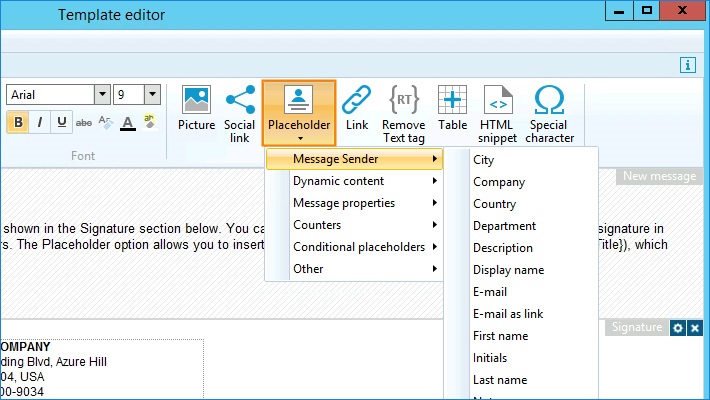
Note: if pronouns are added in a carve up line or have a signaling phrase before them (like Pronouns:), I can add a Remove Text tag. This mode, if the attribute value is empty, the boosted line and the signaling phrase volition not be added. Learn more than nigh using Remove Text tags
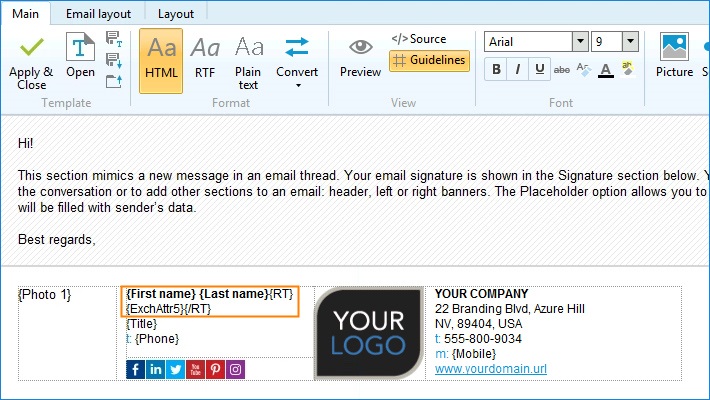
After I'm done, I apply the changes in the signature template editor using the Apply & Close button and submit changes to CodeTwo Exchange Rules Service.
The outcome
No matter which method was used to add the gender pronouns, they volition be added to the specified users' electronic mail signatures. Here'south an instance of how it can look:

CodeTwo Substitution Rules can exist used past organizations to centrally manage their email signatures. It lets companies of all sizes ensure unified brand identity and email compliance, while assuasive It to relieve a lot of fourth dimension and resources.
Starting time your 30-mean solar day costless trial
Read also
- How to measure customer satisfaction with email signatures
- Directly Teams link in an email signature
When Is It Appropriate To Add Pronoun Guide To Your Signature,
Source: https://www.codetwo.com/blog/using-gender-pronouns-in-email-signatures/
Posted by: palmerrecance.blogspot.com


0 Response to "When Is It Appropriate To Add Pronoun Guide To Your Signature"
Post a Comment